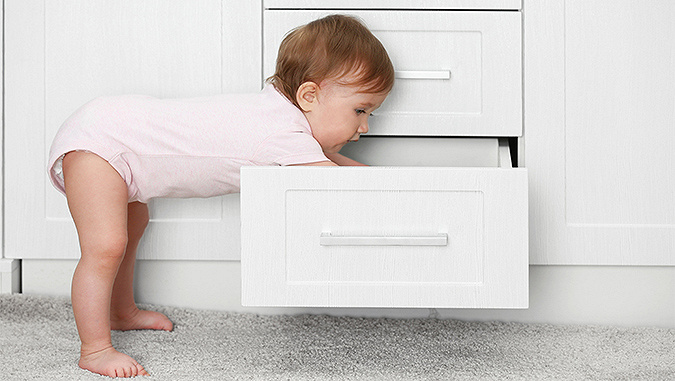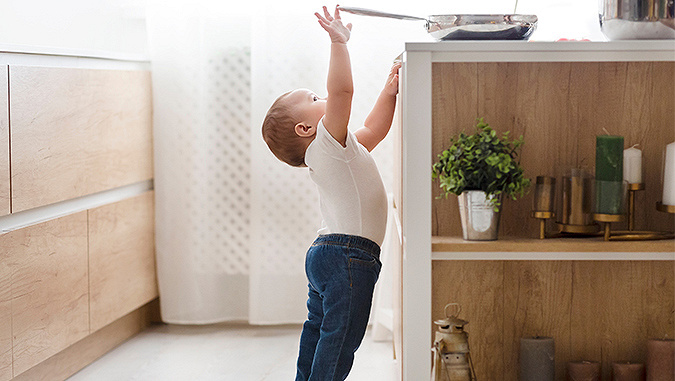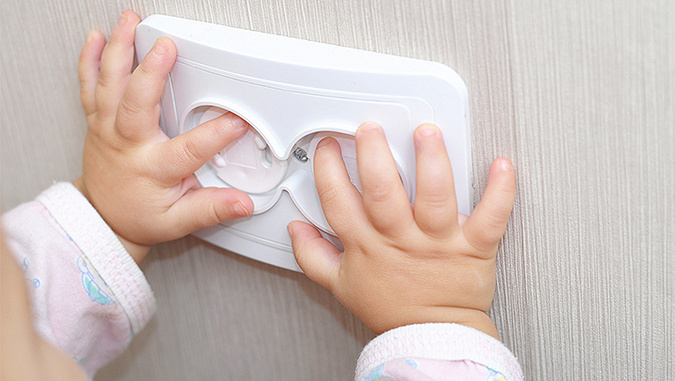Childproofing at home and apartment - which ones to choose
4 min

In everyday life, few people realize that at home there are many places and equipment that can pose a threat to children. Most parents realize this fact, whose child begins to take the first steps. In this article you will learn what safety features should be used in the house to make the child completely safe.
Childproofing - why should you introduce it at home?
Children grow up quickly and before you know it, your little one will cease to be a baby who sleeps most of the time in a cot. Soon they will start to take their first steps, they will be moving faster and faster, opening cabinets, reaching for everything that catches their eye. It is a well-known fact that parents have to have eyes in the back of their heads. A child is not aware of the dangers, does not know what could be dangerous for them. That is why it is worth thinking in advance about solutions that will prevent dangerous situations.
Dear parent, do not miss this moment and childproof all potentially dangerous places in the house before your child starts to move around independently.
Which childproofing features are the most important?
The most important are those that protect your child from a real threat of loss of life or health. This will undoubtedly include plugs for electrical sockets and cables, covers for sharp furniture edges, window locks, as well as drawers and cupboards where medicines, cleaning products etc. are stored.
If you have a gas stove at home, you will need special covers for the gas knobs; if you have an electric or induction stove, you will need covers to prevent burns.
Types of childproofing
There are many helpful accessories on the market that will protect your child from bumps, pinching fingers, falls, burns, cuts or from getting into places where harmful substances are stored.
You can secure cabinets, drawers, and furniture; block windows, doors, and stairs; cover cables and sockets; and protect your child from kitchen hazards.

Furniture, cabinets, and drawers childproofing
Children learn surprisingly quickly by observing their parents' behavior. They see adults opening different cabinets or drawers and pulling out lots of interesting things. Surely they will soon try to do the same!
The danger is not only that your toddler will get their fingers pinched or that objects will fall out of cupboards - be aware that there may be very harmful substances hidden there! A toddler absolutely must not have access to cleaning products or medication! These products are often stored in bathroom cabinets. Fortunately, there are special locks that will protect your child from danger.
We can choose from locks:
- attached with double-sided tape (you don't have to peel the entire lock to open the cabinet - just remove the protection on one side);
- combination locks (similar to bicycle locks);
- magnetic locks (invisibly mounted inside cabinets).
The edges of furniture can be secured with special protective foam tape and their corners with special foam or silicone corners.

Cable and socket childproofing
You probably don't need to tell anyone how dangerous electricity is. Unfortunately, children are particularly interested in cables and sockets. Therefore, all cords and extension cords should disappear from the floor. Prudent parents should hide cables in special protective strips or under the carpet. Special plugs are designed for sockets. These can be bought in many places, e.g. at DIY stores or in children's stores.
Window and door locks
There is a wide range of products as far as window and door locks are concerned:
- locks - prevent the child from opening the window (plastic, lockable, mounted on the window frame or in the window mechanism);
- keyed handles - after turning the key no one is able to open the window;
- protective film - this is put on the glass so that the child cannot break it.
In the case of doors, childproofing devices are available in the form of:
- overlays or stoppers - these prevent fingers from being pinched;
- pads - put under the door to prevent it from closing;
- balcony door lock - prevents the door from opening and also prevents the parent from getting stuck on the balcony.
Fall protection
If you have stairs in your home, it is imperative that it needs childproofing. A fall from such a height can be fatal for a child. Therefore, remember to install special gates. Make sure they are high enough and have a lock that cannot be opened by the child. Remember that children learn quickly.
Such gates are also helpful when you do not have stairs at home, but you want to prevent your toddler from going to another room.
Childproofing in the kitchen
Kitchen - a place full of smells, mysterious substances, attractive products, interesting knobs... and dangers!
First of all, secure all drawers that contain sharp tools. Lock also cabinets with small products (choking hazard) and glass dishes and containers (cabinets, as well as the fridge) before the toddler. You can buy special locks for the oven, electric and induction hobs, covers for gas knobs.
Remember: Bags and baggies scattered around the kitchen are a serious danger! Always put them in one place that is inaccessible to children.
Ideally, organize the kitchen in such a way that its equipment does not pose a threat to the ubiquitous toddler. Keep the kettle and small electrical appliances out of your child's reach.
Also, when designing the kitchen, it is worth taking into account that a small person will be in it at some point. Nowadays, you can place some appliances (e.g. oven, dishwasher) in such a way that they remain out of the child's reach.
An interesting idea is to designate one cabinet in the kitchen just for a toddler. Put toys and plastic containers in it - your child will be able to fumble there and you will know that he or she is safe.
